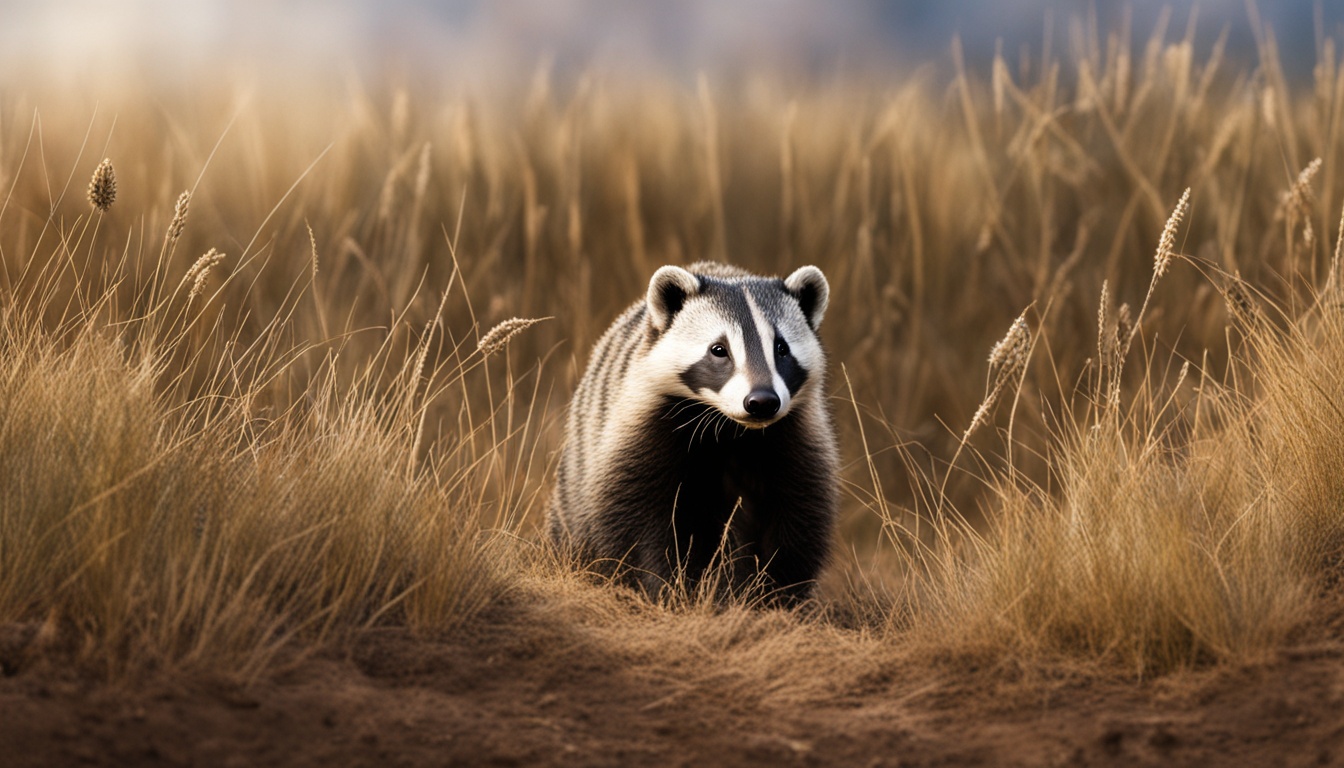When it comes to giant pandas, you may wonder if they have any natural predators in the wild. Well, the truth is that these adorable creatures have very few predators to worry about. While they may face some potential threats, such as jackals, leopards, and the yellow-throated marten, their main predator is actually quite surprising.
Although it may come as a surprise, young giant pandas can be at risk from snow leopards, which are also endangered. These majestic cats can pose a threat to the young pandas, highlighting the importance of protecting these vulnerable species.
Join us as we explore the behavior of giant panda predators, how pandas defend themselves, and the crucial conservation efforts in place to protect these magnificent creatures from their greatest threat: humans.
Giant panda predator behavior
The giant panda, although primarily a peaceful and solitary animal, possesses interesting behaviors when faced with potential predators. While they generally avoid confrontation, pandas have been known to fight back when escape is not possible. They display aggression by lowering their heads and staring directly at their opponent, using their imposing size and strength as a deterrent. Additionally, pandas have powerful jaw muscles and large molar teeth that they can employ for self-defense. Their physical attributes, combined with their agility as climbers and swimmers, contribute to their ability to protect themselves in the wild.
“Pandas exhibit remarkable self-defense mechanisms, relying on their physical strength and formidable teeth to ward off potential predators.” – Wildlife Expert
Despite their formidable defense tactics, pandas are generally peaceful creatures, preferring to avoid conflict whenever possible. They are well-adapted to their environment and have evolved unique behaviors and physical attributes that support their survival. These behaviors, combined with their distinct habitats, contribute to their status as an iconic and beloved species.
To better understand the behaviors of giant pandas, researchers and wildlife experts have conducted extensive studies on their interactions with predators. By observing their behavior in the wild and studying their physical capabilities, scientists gain valuable insights into the fascinating world of these magnificent creatures.
Understanding panda predator behavior not only enhances our knowledge of these beautiful animals, but it also plays a vital role in conservation efforts. By recognizing the threats they face and their natural defense mechanisms, we can better protect pandas and ensure their continued existence in the wild.
Table: Comparison of Giant Panda Defense Mechanisms
| Defense Mechanisms | Detailed Description |
|---|---|
| Aggression | Pandas lower their heads and stare directly at their opponents, using their large size and strength as a deterrent. |
| Physical Strength | Pandas possess powerful jaw muscles and large molar teeth that they can use for self-defense. |
| Agility | Pandas are excellent climbers and swimmers, allowing them to escape and navigate difficult terrain. |
Protecting pandas from predators
Giant pandas, while possessing the ability to defend themselves against most predators, face a more significant threat from human activities. Habitat loss and fragmentation, as well as poaching and illegal trade, pose significant risks to panda populations. Conservation efforts focus on protecting panda habitats, restoring and connecting fragmented areas, and implementing measures to prevent illegal hunting and trade.
Ensuring the preservation of panda habitats is crucial for their survival. By creating protected areas and promoting sustainable land use practices, we can provide a safe haven for these magnificent creatures. It is essential to address the underlying causes of habitat loss, such as deforestation and development, to prevent further displacement of pandas from their natural habitats.
In addition to protecting their habitats, efforts are also underway to combat poaching and illegal trade. Strict enforcement of laws, along with international collaborations, can help prevent panda parts from entering the illegal market. Raising awareness about the importance of panda conservation is also crucial to garner public support and encourage responsible actions towards protecting these beloved animals.

The Role of Local Communities
Engaging local communities in conservation efforts is vital for the long-term success of protecting pandas from predators. Promoting sustainable livelihoods that are compatible with wildlife conservation can incentivize communities to embrace conservation practices. Educating locals about the importance of pandas as key indicators of ecosystem health helps foster a sense of stewardship and pride in protecting these unique creatures.
In conclusion, while giant pandas may have few natural predators, human activities pose significant risks to their survival. By prioritizing habitat protection, preventing illegal hunting and trade, and involving local communities, we can ensure the long-term conservation of these iconic animals.
Panda Predator Habitat and Distribution
Giant pandas primarily inhabit mountain ranges in central China, mainly in Sichuan, as well as neighboring Shaanxi and Gansu provinces. These regions provide the ideal habitat for pandas due to their high altitude forests with dense bamboo growth, which makes up a significant portion of the panda’s diet. The lush bamboo forests not only provide ample food but also serve as shelter and protection for the pandas.
However, the distribution of giant pandas has been significantly affected by human activities. In the past, pandas also lived in lowland areas, but due to farming, deforestation, and development, they have been driven out of their once-inhabited regions. This forced migration has resulted in a conservation-reliant vulnerable species. Efforts are being made to protect and restore their habitats, ensuring the survival of these incredible animals.
Panda Predator Habitat and Distribution Table
| Province | Main Habitat | Main Bamboo Species |
|---|---|---|
| Sichuan | Mountain ranges | Qiongzhuea |
| Shaanxi | Mountain ranges | Fargesia |
| Gansu | Mountain ranges | Qiongzhuea |
The table above provides an overview of the provinces where giant pandas are primarily found and the main habitat characteristics. Sichuan, Shaanxi, and Gansu provinces offer the ideal environment for pandas, with mountain ranges and dense bamboo forests. The main bamboo species in these regions are Qiongzhuea and Fargesia, which are essential food sources for pandas.
Understanding the habitat and distribution of giant pandas is crucial for conservation efforts. By protecting and restoring their habitats, we can ensure the survival of these magnificent creatures and contribute to the preservation of their unique ecosystem.
Panda Predator Conservation
Giant pandas are an iconic species that face conservation challenges due to various human activities. Efforts to protect and conserve pandas are crucial to ensure the survival of the species and the preservation of their unique ecosystem. Conservation initiatives focus on several key aspects, including:
- Preserving and restoring panda habitats: Panda habitats are being protected through the establishment of protected areas and the implementation of sustainable land use practices. These efforts aim to safeguard the natural environment essential for pandas’ survival and ensure the availability of suitable habitats for their population.
- Preventing illegal hunting and trade: Poaching poses a significant threat to pandas, as their body parts are highly valued in the illegal wildlife trade. Strict enforcement measures, along with awareness campaigns and community engagement, are being implemented to combat poaching and disrupt the illegal trade networks.
- Raising awareness: Educating the public about the importance of panda conservation is crucial. Through outreach programs, environmental education, and promoting responsible tourism practices, efforts are made to foster a sense of stewardship and inspire a commitment to protect these magnificent creatures.
In the words of Chinese conservationist Sun Quanhui, “Panda conservation requires a collective effort and a long-term commitment from individuals, communities, and governments worldwide. It’s our responsibility to protect this precious species for future generations.”
Thanks to these conservation efforts, the giant panda’s conservation status has improved over the years. In 2016, the International Union for Conservation of Nature (IUCN) reclassified the giant panda from “endangered” to “vulnerable.” This reclassification is a testament to the progress made in protecting and conserving this beloved species.
| Conservation Efforts | Status |
|---|---|
| Establishment of protected areas | Ongoing |
| Implementation of sustainable land use practices | Ongoing |
| Enforcement measures to combat poaching | Ongoing |
| Educational programs and awareness campaigns | Ongoing |
However, the threat to pandas persists, and continued conservation efforts are necessary to ensure their long-term survival. The future of these remarkable creatures lies in our hands, and it is our responsibility to protect them from further endangerment and preserve their natural habitats.
Conclusion
Giant pandas, although they have few natural predators, face significant conservation challenges due to human activities. Protecting their habitats, preventing illegal hunting and trade, and promoting sustainable practices are crucial for the survival of the species.
Efforts to conserve pandas have shown positive results, but continued action is necessary to ensure their long-term survival and the preservation of their unique ecosystem.
Conservation initiatives focus on preserving and restoring panda habitats, creating protected areas, and raising awareness about the importance of panda conservation. These efforts help address the threats that pandas face and contribute to their overall well-being.
The conservation status of the giant panda has improved over the years, with the species being reclassified from “endangered” to “vulnerable” in 2016. However, the panda predator species still face the ongoing threat of habitat loss, fragmentation, and illegal activities.
Do Giant Pandas Face Predation Threats While Consuming Bamboo?
Yes, giant pandas face predation threats while consuming bamboo. Despite being primarily herbivorous, they are not immune to attacks from predators such as leopards and jackals. However, their diet consists mainly of bamboo consumption by pandas, which helps them minimize the risks of predation.
FAQ
Are there any natural predators of giant pandas in the wild?
Giant pandas in the wild have very few natural predators. Some potential predators of pandas include jackals, leopards, and the yellow-throated marten. Snow leopards, which are also endangered, can pose a threat to young pandas.
What is the behavior of giant pandas when faced with predators?
Adult giant pandas are solitary and peaceful animals, and they usually avoid confrontation. However, if escape is not possible, pandas have been known to fight back to protect themselves. They can display aggression by lowering their heads and staring directly at their opponent. Pandas have physical strength, large molar teeth, and strong jaw muscles that they can use for self-defense. They are also excellent climbers and can swim.
How are pandas protected from predators?
While adult pandas are well equipped to defend themselves against most predators, the main threat to pandas comes from human activities. Conservation efforts focus on protecting panda habitats, restoring and connecting fragmented areas, and implementing measures to prevent illegal hunting and trade.
Where do giant pandas live and what is their habitat like?
Giant pandas primarily inhabit mountain ranges in central China, mainly in Sichuan, as well as neighboring Shaanxi and Gansu provinces. They prefer high altitude forests with dense bamboo growth, as bamboo makes up a significant portion of their diet. However, due to farming, deforestation, and development, pandas have been driven out of lowland areas where they once lived, resulting in a conservation-reliant vulnerable species.
What is being done to conserve giant pandas?
Conservation efforts for giant pandas focus on preserving and restoring their habitats, as well as implementing measures to address the threats they face. These efforts include creating protected areas, promoting sustainable land use practices, and raising awareness about the importance of panda conservation. The conservation status of the giant panda has improved over the years, with the species being reclassified from “endangered” to “vulnerable” in 2016.
What is the importance of panda predator conservation?
Giant pandas, although they have few natural predators, face significant conservation challenges due to human activities. Protecting their habitats, preventing illegal hunting and trade, and promoting sustainable practices are crucial for the survival of the species. Efforts to conserve pandas have shown positive results, but continued action is necessary to ensure their long-term survival and the preservation of their unique ecosystem.











